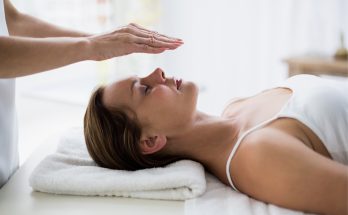Meditation is one of the fastest growing trends in the US; millions of people are adopting the practice to deal with their fast paced and stressful lives. In treating stress-related disorders, physicians are learning that prescribing meditation, yoga, outdoor play, creative hobbies, and other unconventional wellness activities may actually help more than simply prescribing medications.
Finally, western medicine is catching up to what spiritual healers in ancient cultures all over the world have already known: meditation heals both the mind and the body.
How to Do It
There are several ways to meditate. You can sit or lie comfortably and focus on your breathing and a word or phrase. You can listen to music or repetitive sounds like breaking waves, rainfall, or birds chirping, listen to a guided meditation, or use imagery. You can also meditate while walking, doing yoga, tai chi or qi gong, or while doing a repetitive activity such as pulling weeds or sweeping the floor.
Sound Bath Meditation
Because your mind can’t focus on more than two things at a time, focusing on your breathing while also repeating a mantra or listening to music or sounds helps you to block out distracting thoughts. Sound bath meditation works on this principle by bathing you in sound, helping you to tune out the outside world and bring your focus inward. A sound bath also introduces vibration to your meditation practice, which has been said to have its own healing powers.
Sound bath meditations use a variety of instruments, most commonly drums, Tibetan or crystal singing bowls, gongs, chimes, and tuning forks.
Gina Sutter, a teacher from St. Petersburg, Florida, describes a recent drum bath session she participated in on the beach.
“There were about six of us in the group. We were in a circle, lying on the sand. It was nighttime, so the stars were out, but I mostly kept my eyes closed. The leader moved around the circle, beating her drum continuously. I focused on my breathing and on the drum sounds. As she came closer, I could feel the vibrations from the drum. She would pause over me, beating the drum just above my body. The sound sent strong vibrations through me. It was a wonderful feeling. She would move on to the next person and continue around the circle. Each time she came to me, I could sink deeper into a relaxed state with the vibrations. It was truly the most relaxing experience I have had, and I feel like it stayed with me for some time afterwards.”
Meditation teacher Lisa Bromfield explains that if energy in your body is blocked, it will show up in some manner.
“If any of your chakras, the seven energy centers in your body, are blocked, you will experience physical or emotional disturbance,” she says, “Each chakra corresponds to a different frequency. The sound of the drum, and the vibrations that sound emits, help to unblock the chakras, allowing energy to flow through you and help you reach a deeper state of relaxation.”
If that sounds a little far out to you, hold onto your peace sign. In spiritual healing, the seven chakras frequencies correspond to the Solfeggio frequencies, specific tones that have been shown to promote emotional healing. The following is a list of the chakra frequencies along with the corresponding Solfeggio healing property.
396 Hz: Root Chakra, Release of fear and guilt
417 Hz: Sacral Chakra, Undoing negative situations and facilitating change
528 Hz: Solar Plexus, Transformation and miracles, DNA repair
639 Hz: Heart Chakra, Re-connecting and balancing, relationships
741 Hz: Throat Chakra, Solving problems, expressions/solutions
852 Hz: Third Eye Chakra, Awakening intuition, returning to spiritual order
963 Hz: Crown Chakra, Awakens oneness and interconnectedness with the universe
Everything in the universe is made of molecules that are in constant motion. In other words, everything is made of energy, and everything has a vibrational frequency. The theory is this:
A healthy human body has an overall frequency of around 62-72 Megahertz (MHz.).
You can raise your body’s frequency by engaging in healthy activities and keeping a positive outlook. Negative thoughts lower your frequency about 12 Hz, but positive thoughts can raise it by 10 Hz and prayer and meditation by 15 Hz. Fresh produce has a high frequency of about 20-27 Hz, while meats are 3-5 Hz, and processed foods are close to zero.
Essential oils have the highest frequencies of any natural substances. Rose oil measures at 320 MHz, lavender at 118 MHz, and peppermint at 78 MHz. Aromatherapy works by the principle that when two sources of frequency come into contact, the more powerful source will raise the frequency of the lower source.
While we want to keep our body’s overall frequency high to avoid illness, we should also spend time lowering our brain wave frequency through relaxation and meditation. This is where sound bath meditation is helpful. Sound bathing both raises the body’s frequency while also relaxing the brain.
Niajae Wallace, a certified sound bowl instructor, says that sound baths overcome energy blocks, activating the lymphatic system, while calming the brain.
“People often gain great clarity after participating in sound healing,” she says, “Afterwards, you may experience bursts of creativity or are better able to make big decisions.”
You can experience a sound bath by yourself. Simply put on some music that has a steady rhythm. You can use a recording of drum music, singing bowls, or chanting monks, or create your own sound if you have instruments at home. Focus on your breathing and the music. When distracting thoughts enter your mind, push them out by turning your focus back to your breath, or repeating a mantra in time with the music. It may take practice to reach deeper states of relaxation but keep at it. Like the Beach Boys said, it’s all about those good vibrations.



